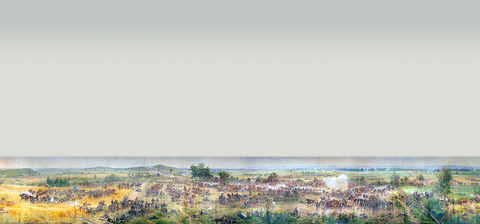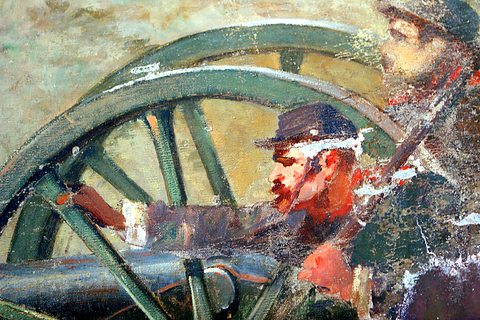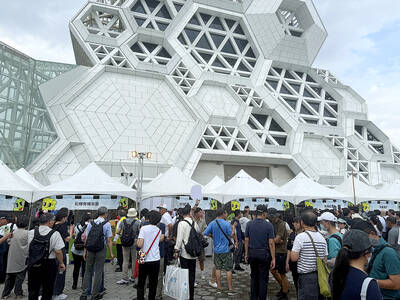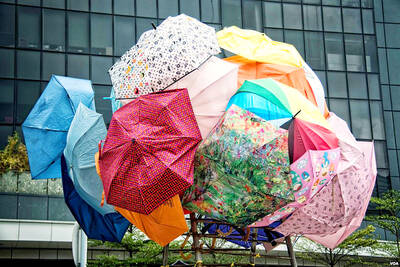Just two decades removed from the horrors of the US civil war, throngs of sightseers stepped into the center of a gigantic painting-in-the-round to imagine what it might have felt like to be in the scrum of battle on the hallowed ground of Gettysburg.
The realism of this cyclorama, the story goes, brought some veterans to tears.
One part art and one part commercial venture when it opened in Boston in 1884, this colossal canvas, now in Gettysburg, has become as ragged as an old Army tent -- worn, torn, sagging and covered in grime. Art conservators here are embarking on a US$9 million federally financed project to restore vigor to a painting that has lost its visceral power.

This enormous undertaking -- the work is just under 111m in circumference and 8m tall -- is the largest conservation project for a single painting ever done in North America, according to the National Park Service and its private partner in the effort, the Gettysburg National Battlefield Museum Foundation.
The cyclorama is a major draw at the park, where it recreates Pickett's Charge, the climax of the Battle of Gettysburg on July 3, 1863, which marked the beginning of the end for the Confederates. Conceived as a tourist attraction, the 360 degrees vista was "the Imax of its day," said Robert Wilburn, president of the Gettysburg National Battlefield Museum Foundation.
Conservators face the challenge of preserving something that was never meant to last. Cycloramas depicting historical events had their heyday in the latter half of the 19th century, when entrepreneurs commissioned artists and installed their grand efforts temporarily in custom-designed buildings, sending them on tour much as a blockbuster art show today moves from museum to museum.

PHOTOS: NY TIMES NEWS SERVICE
"These things were painted as economic ventures and then were discarded in a couple of years," said David Olin of Olin Conservation Inc, which is leading the project along with Perry Huston and Associates. Paul Philippoteaux, a French painter, and his team of 20 were hired to complete four nearly identical Gettysburg cycloramas; one has disappeared, one became tent material, one is in storage at Wake Forest University, and the other wound up at Gettysburg in 1913.
It had a rough journey. In its early years, the cyclorama traveled from Boston to Philadelphia, then back to Boston, unrolled and then packed up again and again. It was stashed in a crate, stored in a parking lot, subjected to moisture and rot, and sliced into panels for display in a Newark department store, losing pieces along the way. Even when this bit of American heritage came under the park service's stewardship in the 1940s, the abuse continued: for decades it hung improperly in a museum with wildly fluctuating humidity, poor ventilation and a leaky roof.
All these indignities and more have sabotaged Philippoteaux's attempt to make his battle scene grippingly real. He wanted not so much to create fine art, but to spin the illusion, if just for an instant, that a viewer was in the midst of a historic moment. To do that, he surrounded viewers with a chaotic scene of thousands of soldiers charging with rifles and bayonets, ruin in their wake: splayed bodies, fallen horses, cannon-ravaged farmland and clouds of smoke and dust. More than 5,000 soldiers became casualties in one gruesome hour during Pickett's Charge.
Long before movies and computer-generated special effects, Philippoteaux deployed optical tricks to create a stand-in for the real carnage of war. Now that the painting has been stripped of most of these devices, its potency has waned. The work feels almost quaint, wearing more the mantle of historical artifact than the veil of artifice.
In its current condition, the painting "really doesn't give the viewer any sort of feeling that they're out there" on the battlefield, Olin said. "Our intent is to bring back the artist's intent."
The conservators will try to evoke the you-are-there feeling. Wilburn of the foundation said, "We're trying to get as close as we can to creating the illusion of being in the cyclorama in 1884. You'll get that total-immersion experience."

Water management is one of the most powerful forces shaping modern Taiwan’s landscapes and politics. Many of Taiwan’s township and county boundaries are defined by watersheds. The current course of the mighty Jhuoshuei River (濁水溪) was largely established by Japanese embankment building during the 1918-1923 period. Taoyuan is dotted with ponds constructed by settlers from China during the Qing period. Countless local civic actions have been driven by opposition to water projects. Last week something like 2,600mm of rain fell on southern Taiwan in seven days, peaking at over 2,800mm in Duona (多納) in Kaohsiung’s Maolin District (茂林), according to

It’s Aug. 8, Father’s Day in Taiwan. I asked a Chinese chatbot a simple question: “How is Father’s Day celebrated in Taiwan and China?” The answer was as ideological as it was unexpected. The AI said Taiwan is “a region” (地區) and “a province of China” (中國的省份). It then adopted the collective pronoun “we” to praise the holiday in the voice of the “Chinese government,” saying Father’s Day aligns with “core socialist values” of the “Chinese nation.” The chatbot was DeepSeek, the fastest growing app ever to reach 100 million users (in seven days!) and one of the world’s most advanced and

The latest edition of the Japan-Taiwan Fruit Festival took place in Kaohsiung on July 26 and 27. During the weekend, the dockside in front of the iconic Music Center was full of food stalls, and a stage welcomed performers. After the French-themed festival earlier in the summer, this is another example of Kaohsiung’s efforts to make the city more international. The event was originally initiated by the Japan-Taiwan Exchange Association in 2022. The goal was “to commemorate [the association’s] 50th anniversary and further strengthen the longstanding friendship between Japan and Taiwan,” says Kaohsiung Director-General of International Affairs Chang Yen-ching (張硯卿). “The first two editions

It was Christmas Eve 2024 and 19-year-old Chloe Cheung was lying in bed at home in Leeds when she found out the Chinese authorities had put a bounty on her head. As she scrolled through Instagram looking at festive songs, a stream of messages from old school friends started coming into her phone. Look at the news, they told her. Media outlets across east Asia were reporting that Cheung, who had just finished her A-levels, had been declared a threat to national security by officials in Hong Kong. There was an offer of HK$1m (NT$3.81 million) to anyone who could assist